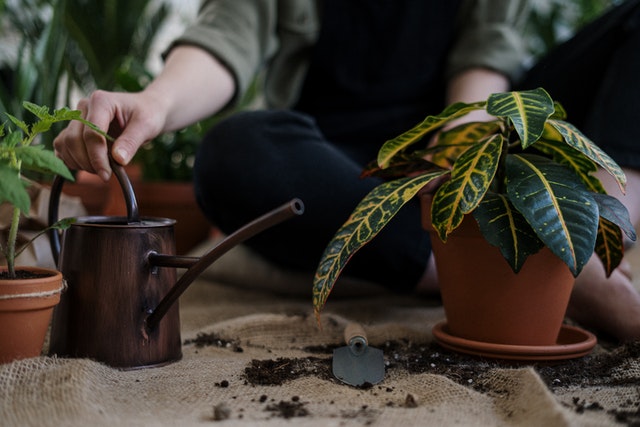One of the most challenging aspects of plant care is making sure that your houseplants receive enough water. Everyone, including experienced plant owners, has been responsible, at some point, for the demise of a plant due to insufficient or excessive watering. As a result, the question “How do you know when it’s time to water your houseplants?” isn’t the only one that novices have.
I’ll tackle some frequently asked questions and misconceptions about watering houseplants in this plant care guide:
- What is the average daily water requirement for a plant?
- How much water does your plant require each time you water it?
- How can you know whether your plant requires water?
- How can you ensure that you don’t overwater your plants?
Let’s embark on an adventure to learn how to enhance the way you water your houseplants. The act of watering your plants does not have to be a stressful experience; rather, it can be a time when you get to appreciate the beauty of your plants.
Table of Contents
What is the average daily water requirement for a plant?
Watering houseplants may be challenging, especially if you’re a newbie. It is quite simple to have the misconception that all plants like water and want it on a daily basis in order to live. When you water your plant, it almost seems as though you are providing it with food and showing it love at the same time.
Plants, on the other hand, are not the same as people or pets in that they do not require continuous attention. The majority of houseplants like it when you let the soil in their pots dry out completely before watering them again. If you water your plant every day, you will eventually overwater it, which will result in its death in a very short amount of time.
Simply said, don’t water your plant every day! In most cases, watering your plant once every seven days should be plenty. This gives the soil a chance to dry out a lot, which is good for most plant species.
We now know that rather than watering our plants every day, we should do it once per week. The following question you can ask is, “How much water should be used to water your plant?” That is a really good question, and we will check into it right away.
How much water does your plant require each time you water it?
Wouldn’t it be fantastic if you could water your plant properly every time? It is fairly simple to overwater your plant, but it is also pretty simple to forget to water it and let it become dry. The question now is, how do you determine the appropriate amount of water to give your plant? Let’s look at the ways in which your container and soil will help you with your project:
A container with a drainage hole
If you’ve placed your plant in a container that has a drainage hole in it, you’ve already accomplished something significant toward your goal. When it comes to watering your plants, a drainage hole is a very helpful item to have.
It is important that you carefully and gently water your plants so that you can determine the optimal amount of water that each plant requires. When you water your plants in a slow, steady manner, you allow the soil time to take in the moisture that you are providing.
All of the surplus moisture, or water that the soil is unable to take in any further, will eventually drain out of the bottom of the container. If you turned your plant upside down and let the soil drain for about five minutes, you should have given your plant just the right amount of water for this week.
A saucer beneath the pot
If you put a saucer under your pot like I do, which has a hole in the bottom for drainage, you need to take one additional step. Move the container away from the saucer so you can water your plants without getting water on the saucer. The water will leak from the pot, but the saucer will collect it and prevent it from escaping.
Because of this, your plant will continue to sit in the extra moisture, which is quite similar to what happens when you don’t use a container that has a drainage hole. It will save you time and help keep your home cleaner if you water your plants while they are perched above a sink.
A container lacking a drainage hole.
In the event that your container does not have a drainage hole, you will need to ensure that the plant you’re growing is tolerant of high levels of humidity.
The soil in the container will not be able to absorb any extra moisture, so it will fall to the bottom of the container. Your plant might perish if this water remains in this spot for an extended period of time since it will cause the roots to rot.
When utilizing a pot that does not have a drainage hole, fortunately, there are a few options available to you! Using Smart Gravel and Leca, you may give your pot an elevated base by raising the bottom.
On top of this layer, you may place your plant and soil so that it is protected from the water that is located at the bottom of the pot. With this elevated bottom, you will have a far better chance of maintaining the plant’s health in a container that does not include a drainage hole.
Some plants, such as cacti and succulents, require a drainage hole to remove excess moisture: they prefer dry soil. Plants that thrive in damp environments, such as the Peace Lily and the Spider Plant, don’t need their containers to include drainage holes.
How can you know whether your plant requires water?
Already, we’ve picked up a lot of useful information! Wonderful, now we not only know that we shouldn’t water a plant every day but also how much we should be watering that plant. What if you believe your plant requires extra water? What are some of the warning indicators that your plant requires more water? These are really good questions, which I will address in the next section.
It’s quite simple to overwater a plant since it “appears” thirsty. In order to determine whether or not your plant really does require water, there are a few factors we need to look at:
- At least 7 days have passed since the last time the plant was watered.
- The top inch and a half, or 2.5 centimeters, of the soil is dry.
- The plant is showing signs of sagging or curling up.
- There is no water at the bottom of the saucepan.
You can water your plant once you’ve determined that all of these parameters have been satisfied. You won’t have to worry about overwatering your plant now that it’s had time to dry up and breathe.
How can you ensure that you don’t overwater your plants?
Overwatering plants is one of the most common mistakes new plant owners make. Overwatering your plants is a simple mistake to do, and even the most experienced gardeners are guilty of it. To avoid overwatering your plants, there are a number of strategies to ensure that you aren’t doing so:
- Make sure the container you use has a drainage hole.
- Your pot should have a raised bottom with no drainage holes.
- Use soil that drains well.
- You should only water your plants once a week.
- Allow your plant to absorb the moisture.
We’ve previously gone over the necessity of drainage holes or raised bottoms earlier in this guide. Both of these features should be present. These will guarantee that the plant and the soil in the pot will never become bogged down in a pool of water at the bottom of the container.
Because a pool of water like this may so easily lead to root rot, the elevated bottom and drainage hole work together to eliminate this risk.
A well-drained soil is ideal for removing excess water. This prevents your plant from sitting in wet soil. Calathea is one of the few plants that thrives in this habitat. However, most plants prefer soil that has been allowed to dry out for a few days before being watered again.
A good rule of thumb for novice gardeners is to limit the frequency of watering their plants to no more than once every seven days. This allows you to avoid overwatering your plant, and over time you will learn if it needs more or less water. However, watering more than once a week is quite unusual, so keep it to once a week at the most.
It is also essential to provide your plant with the necessary time to take in the moisture. Even after you’ve watered your wilting plant, don’t expect it to bounce back immediately. This is not an indication that you have not watered your plant sufficiently; rather, it is a sign that the plant still needs to absorb the moisture that it has already been given.
If you give your plant at least six hours to take in the moisture, you’ll see that it immediately returns to the appearance it had before you watered it.
I appreciate you taking the time to read my article. I really hope that this information is of use to you in maintaining the health and beauty of your plants.
Frequently Asked Questions
How much water does a plant need per day?
You should only water your plant once a week. You risk giving your plant too much water if you water it every day, and it will die rapidly.
How much do you need to water your plant in a pot with drainage holes?
You should carefully water your plant until it begins to seep water through the drainage holes at the bottom of the container. You may now let it drain for five minutes, and your plant should have received the ideal amount of water.
How much do you need to water your plant in a pot without drainage holes?
Water your plant in a pot without drainage holes only if the soil is dry. This prevents you from watering your plant more than it needs to be.
How can you tell if your plant needs water?
If you haven’t watered your plant in at least seven days, the soil around it will be dry, and the plant’s leaves will be drooping slightly to indicate that it needs watering. Do not water your plants again until at least 7 days have passed since the last time you did so. If you water your plant too frequently, there is a risk that you will overwater it.
How can you make sure you don’t water your plants too much?
You may allow any extra moisture to escape from the pot by using containers that include a drainage hole. Having a container with a raised bottom can also help you avoid drowning your plants in excess water. This prevents the roots and soil from becoming soaked in water by elevating them off the bottom of the container.
Photo by cottonbro: https://www.pexels.com/photo/person-holding-brown-ceramic-mug-with-green-plant-4503263/



